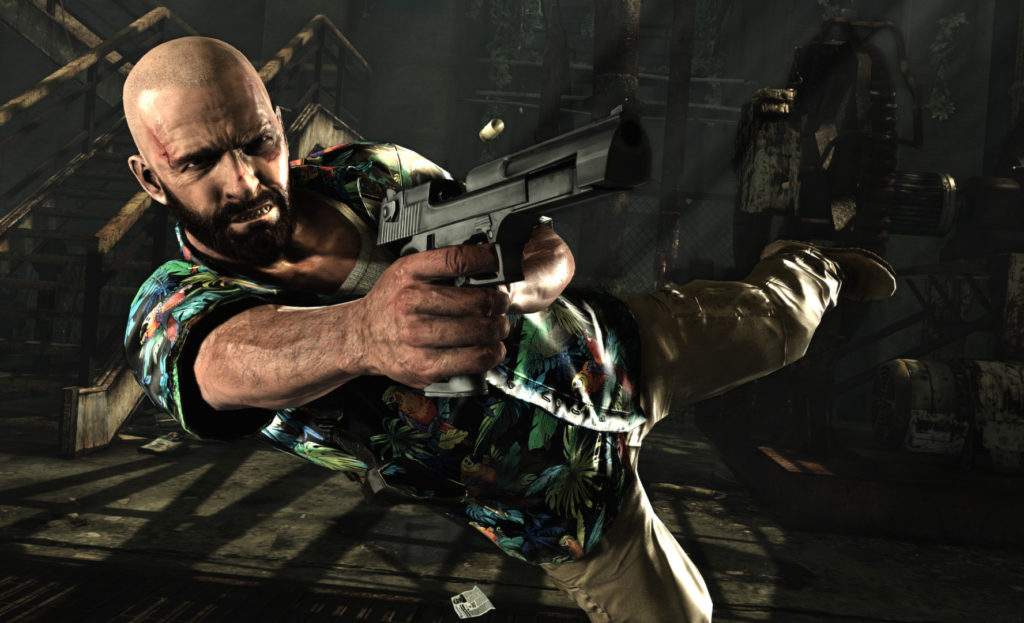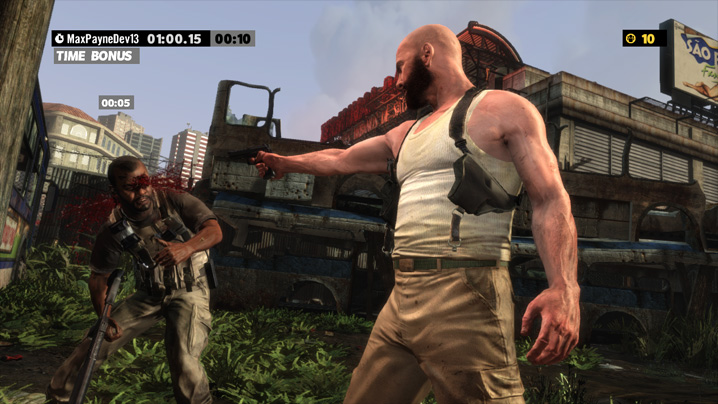It’s hard to believe that Max Payne has really been gone since 2003. Max Payne 2: The Fall of Max Payne didn’t set the world on fire by any means, but the series garnered enough of a cult following thanks to its flashy mechanics and endearing style to make the lack of any follow-up (besides the awful Marky Mark movie) a tad strange. “Max Payne’s long journey through the night will continue,” we were promised.
Max Payne is back, and his journey through depressing noir-esque story tropes lies ahead of him. Max Payne 3 sees our downtrodden hero in Brazil, having been run out of New Jersey. For those worried about the series ditching its film-noir roots, the opening of the game features not one but several narrative time-skips, all narrated with James McCaffrey’s gruff voice. The story is far grimmer than Max Payne has ever really been, though; it’s a little jarring at first, although it probably wouldn’t have served anyone well for Rockstar to simply ape Sam Lake’s tongue-in-cheek writing.
Older, tougher, paunchier Max is having a rough ride. In an amusing twist, he’s now addicted to the painkillers that served as health items in the previous games, and using them in Max Payne 3 results in a disorienting blur effect. In fact, the game is rife with these stylish blurs – cutscenes are filled with odd smearing effects, scan lines, and color shifting. It’s a bold visual look, to be sure, although some people may find it irritating. In an oddly Michael Mann-esque move, important snippets of dialogue appear on the screen as well, sometimes turning cutscenes into a video game version of Man on Fire. The game is still decidedly noir, but in a grittier, more grounded neo-noir sense. Most of the game takes place in Brazil’s seedier areas, and a traditional Rockstar ensemble cast of weirdos rotates around him as the story progresses. Gone are the comic pages, and gone is the New York City snow.
The gameplay itself, however, has received a less radical makeover. The biggest stuff is, funnily enough, the small details. For a game about leaping around like Chow-Yun Fat, Max Payne 3’s animation is surprisingly well grounded in reality. Diving Max headfirst into a wall will cause him to end his elegant dive and instead fall to the ground to pick himself up. Shooting an enemy in the head with a high-caliber weapon will result in a grisly exit wound. Carrying a rifle but firing a pistol forces Max to hold the bigger gun in his off hand, and firing two pistols will make him drop the carbine altogether. Hell, the wrinkles in the back of his shirt will animate as he jogs through the level.

Despite all this, Max Payne 3 still does what the series does best, and these details are more of a coat of paint rather than a shift in gameplay style. The game is still mostly about jumping through the air holding two guns at the same time in slow motion, something that was much trendier back when we thought The Matrix sequels were going to be awesome. Seeing this style return in Max Payne 3, in a world where regenerating health and “realistic” military shooters reign supreme, is a godsend. The always-impressive Euphoria animation tool that Rockstar employed in Grand Theft Auto IV and Red Dead Redemption is given a real workout here, putting out some of the most amazing-looking action in the business. The detail in which characters run, dodge, and react to bullets is almost too real in some places – there’s something both incredibly satisfying and oddly grim about the murder on display here. Purists will note that Max Payne 3 has a cover system, but shoot-dodging through the air is far more fun and usually more effective, as well.
There is a multiplayer mode, which is new to the series at large. It works surprisingly well, mostly because of the logic-defying inclusion of slow motion. Essentially, anybody within the line of sight of someone activating bullet-time will also go into slow motion, which is kind of genius. It’s certainly unique, and it makes the otherwise standard fare more interesting. The best mode is Payne Killer, in which one player is Max Payne and the other is his friend Raul Passos. Everyone is on a team against those two named characters, and whoever kills them becomes the next Payne or Passos, and has to fend off the rest of the players until they get killed, etc. It’s a fun concept that concentrates the action and also highlights the best parts of Max Payne, i.e. shooting a lot of goons. The other modes are fun, but the squirelly character control and reliance on jumping around with semi-auto guns can occasionally turn matches into a bit of a clusterfuck.

The campaign is where most people will spend their time, as its both the most interesting part of the game and also very long, by current standards. It’s also brutishly difficult in spots, since it completely forgoes a modern regenerating health system and instead relies on the old Max Payne mechanic of pills serving as health packs. It’s another feature that feels refreshing, even though it’s a bit of a throwback. However, the checkpointing in the campaign can be unforgiving, forcing the player to redo long sections. It’s also an incredibly verbose game, and some people might be put off by the amount of times the action is broken up by short cutscenes. The dialogue is good enough that this is only really a problem on second playthroughs, since these scenes mask load times and can’t be skipped until the game is done preparing the next segment. The campaign also features an arcade mode, which adds a scoring system, and New York Minute, which is a fun returning mode in which a 60 second timer is counting down and seconds are added for killing enemies. There’s plenty on offer in the game.
It’s not as earth-shattering as a Grand Theft Auto, but Rockstar has definitely put their mark on Max Payne as a series with this entry. The story wraps up nicely, and it’s interesting to see Max in a game with a much darker tone, especially when, for the most part, the grim elements are handled extremely well. It’d be remiss to end this review without mentioning the soundtrack, composed by noise-rockers Health – their work adds a lot to the atmosphere of the game, with some spots sounding like a John Carpenter flick. It’s great stuff. Fans disappointed with the new direction of the story will at least be happy to know that the gameplay itself is still pure Max – diving, shooting, and grumbling his way through Brazil.